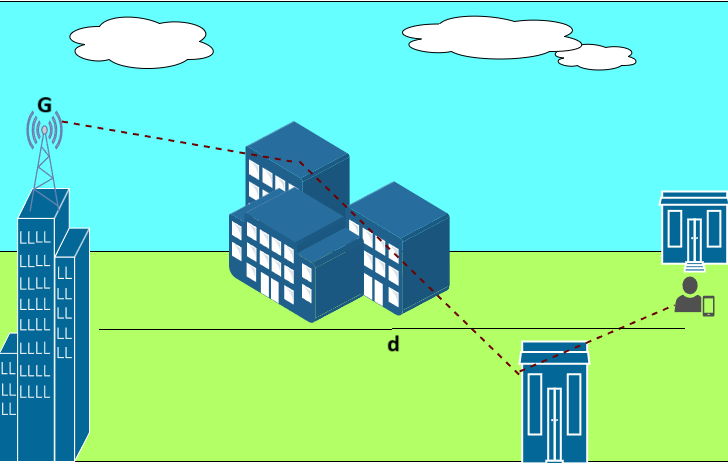Pathloss and Shadowing
Link budget is an important aspect of wireless communication systems design. It accounts for all gains and losses. Two major factors that cause a variation in the received signal(loss) are Pathloss and shadowing. Thus, an accurate characterization of these two effects is crucial for planning the link budget. Let us now understand these effects in detail.
Pathloss
Pathloss is a measure of signal attenuation (i.e. reduction in received signal power) along its path from the to . Mathematically, linear pathloss is defined as the ratio of the transmit power to received power given as
In general, the recieved power is dependent on the following factors:
- Antenna gains of and , and respectively. Antenna gain measures the efficiency of an antenna to focus the signal energy in a specific direction. We can say that a direction-specific antenna(the one with higher G) leads to a increase in .
- Distance between the and , . The recieved power decreases with distance.
- Signal wavelength, . Signals with higher wavelengths travel effectively over longer distances and can also bend around obstacles due to their low carrier frequency. This indicates that increases.
From the Friis free-space transmission equation,
where, is the combined antenna gain.
The above expression for recieved power is in coherence with our understanding.
we can now express Pathloss as
where, is the pathloss at a reference distance .
The above discussion pertains to free-space propagation. In terrestrial wireless networks, however, the presence of multipath components causes the pathloss characteristics to vary across different regions. This variation arises from the constructive and destructive interference of multipath signals at the receiver. To account for such effects, several empirical pathloss models have been developed, including the Okumura, Hata, and COST-231 models. These models incorporate environmental factors, the pathloss exponent, operating frequency, and the heights of the transmitter and receiver antennas to more accurately characterize signal attenuation.
In this experiment, the Okumura pathloss model is employed to simulate large-scale signal attenuation under realistic terrestrial propagation conditions. The pathloss at a distance d can be expressed using the Okumura model as
where is the free space pathloss, is the median attenuation in addition to free space path loss across all environments, and are the transmitetr and reciever height gains and is the gain of the environment.
Pathloss with shadowing
Now, after understanding the concept of pathloss, have you wondered if the pathloss in any direction of the same distance is equal? Not necessarily. This is due to the effect of shadowing! Not just the distance between the and , but also the propogation environment, containing obstacles that lead to absorption, reflection, and scattering etc of the signal leads to an attenuation of the received signal power. This attenuation is a random value. This leads to an additional term in the pathloss equation as follows
The most common model for this additional attenuation, , is log-normal shadowing. This model has been empirically confirmed to accurately capture the variation in received signal power in both outdoor and indoor radio propagation environments.
where . is the mean pathloss and mean attenuation due to the obstacles. The mean power varies with distance due to path loss and the fact that average attenuation from objects increases with distance due to the potential for a larger number of attenuating objects. is the standard deviation of the environment ranging from four to thirteen.
We can view the visual illustration of Pathloss and shadowing in the below figure.

